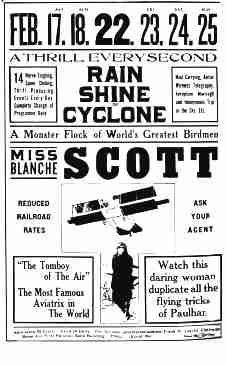Blanche Stuart Scott: One of America's Earliest Aviatrixes
By on Sep 6th 2017
In 1910, a woman set out in an automobile across the country to prove that women were well-equipped to drive automobiles. This feat made her the second woman to drive across the United States. Several months later, she also became the first American woman to take a solo hop into the air.
Blanche Stuart Scott was born on April 8, 1884. From a young age, she was an early automobile enthusiast. Her father, a successful businessman, owned a car that she drove around before there were any age restrictions on driving. Her family viewed Blanche as a tomboy and sent her to finishing school; however, this didn't change her interest in facing challenges and she continued to accomplish feats that were, at the time, considered manly.
Automobile Adventure
Before Blanche took to the air, she made her mark on the ground. On May 16, 1910, Blanche Scott left New York City with her only passenger, a reporter named Gertrude Buffington Phillips.
The New York Times reported on their departure on May 17:
Miss Scott, with Miss Phillips as only companion, starts on long trip with the object of demonstrating the possibility of a woman driving a motor car across the country and making all the necessary repairs en route. Miss Blanche Stuart Scott yesterday started in an Overland automobile on a transcontinental journey which will end in San Francisco.
They reached San Francisco on July 23, 1910, making Blanche Scott the second woman (after Alice Huyler Ramsey) to drive an automobile coast-to-coast across the United States. The trip, sponsored by the Willys-Overland Company, was the first westward journey, whereas the first cross-country trip by Ramsey was eastward.
Blanche Scott gained a fair amount of recognition and much deserved respect after her cross-country journey. At the time of her adventure, there were only 218 miles of paved roads outside of the cities. Considering New York City and San Francisco are nearly 3,000 miles apart-it was a huge deal.
Taking to the Sky
 Blanche's automobile adventure also put her in close proximity to aviation. While passing through Dayton, Ohio, she witnessed a Wright aircraft in flight. And after she reached California, she received her first airplane flight.
Blanche's automobile adventure also put her in close proximity to aviation. While passing through Dayton, Ohio, she witnessed a Wright aircraft in flight. And after she reached California, she received her first airplane flight.
Her notoriety attracted the attention Jerome Fanciculli, Vice president and General manager of the Curtiss Exhibition Company. Mr. Fanciculli, whose duties included establishing aviation schools and directing sales of Curtiss airplanes in the U.S. and Europe, asked Scott if she wanted to learn how to fly. Even though Glenn Curtiss wasn't nearly as enthused by her stunt as Fanciculli, he agreed to teach her. Blanche Scott was the first and only woman to ever receive flying lessons directly from Glenn Curtiss.
By September of 1910, Scott was ready for her solo flight.
To prevent her aircraft from gaining enough speed for flight while she practiced taxiing, Glen put a wood block behind the throttle. Somehow the block became dislodged, and on September 2, 1910, Blanche Scott became airborne. Whether this first flight or -hop- was intentional or not is still up for debate. At any rate, she managed to fly 40 feet in the air and continued her lessons.
In October, she debuted as a member of the Curtiss team at a Chicago air meet on October 1- 9. She was known for flying upside down and for performing her -death dives.- Throughout her aviation career, Scott set a number of records, including the first woman to fly at a public event, the first woman to fly a long distance, and the first female test pilot. So while she may or may not officially be the first woman to fly in the United States, she certainly dominated the skies in her own right.
Tomboy of the Air
 Blanche Scott performed the lead role in the first film made about flying, called The Aviator's Bride. As the first woman stunt pilot, she was the -Tomboy of the Air,- proving that she never did shed her tomboy qualities of her youth.
Blanche Scott performed the lead role in the first film made about flying, called The Aviator's Bride. As the first woman stunt pilot, she was the -Tomboy of the Air,- proving that she never did shed her tomboy qualities of her youth.
Scott suffered a serious airplane accident in 1913 that took her a year to recover from. She didn't fly much after that and retired from active flying in 1916. She cited the public's fascination with crashes and the inequality for women in aviation as reasons for her departure.
Post-flying, she became involved with screenwriting and spent many years as a radio personality. Her love of aviation and flying, however, never abated. In September 1948, she became the first woman passenger to ride in a jet plane. The Aeronautics Association of the United States honored Scott in 1953 and in 1954, she became a consultant to the United States Air Force Museum. She helped the museum acquire more than $1 million worth of early aviation artifacts. The Antique Airplane Association honored her on the 50th anniversary of her first flight and in 1980, U.S. Postal Service honored her with a commemorative stamp.
Blanche Stuart Scott died January 12, 1970, at the age of 84 in Rochester, New York.
Sources:
https://airandspace.si.edu/explore-and-learn/topic...
https://airandspace.si.edu/stories/editorial/first...
http://www.utdallas.edu/library/specialcollections...
https://www.womenofthehall.org/inductee/blanche-st...





